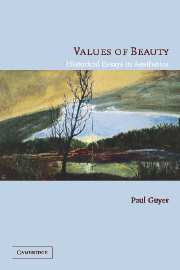Book contents
- Frontmatter
- Contents
- Introduction
- Acknowledgments
- Abbreviations Used in the Text
- I MOSTLY BEFORE KANT
- II MOSTLY KANT
- 3 The Harmony of the Faculties Revisited
- 4 Beauty and Utility in Eighteenth-Century Aesthetics
- 5 Free and Adherent Beauty
- 6 Kant on the Purity of the Ugly
- 7 Beauty, Freedom, and Morality
- 8 The Ethical Value of the Aesthetic
- 9 The Symbols of Freedom in Kant's Aesthetics
- 10 Exemplary Originality
- III MOSTLY AFTER KANT
- Bibliography of Works Cited
- Index
4 - Beauty and Utility in Eighteenth-Century Aesthetics
Published online by Cambridge University Press: 05 June 2012
- Frontmatter
- Contents
- Introduction
- Acknowledgments
- Abbreviations Used in the Text
- I MOSTLY BEFORE KANT
- II MOSTLY KANT
- 3 The Harmony of the Faculties Revisited
- 4 Beauty and Utility in Eighteenth-Century Aesthetics
- 5 Free and Adherent Beauty
- 6 Kant on the Purity of the Ugly
- 7 Beauty, Freedom, and Morality
- 8 The Ethical Value of the Aesthetic
- 9 The Symbols of Freedom in Kant's Aesthetics
- 10 Exemplary Originality
- III MOSTLY AFTER KANT
- Bibliography of Works Cited
- Index
Summary
There was considerable debate about the relationship between beauty and utility in eighteenth-century aesthetic theories from Shaftesbury to Kant. But nobody gave a plausible account of this relationship until Kant, and even he failed to give an extensive statement of the key premise on which his solution to this puzzle rests, or even an explicit statement of his solution, at least until many sections after he had first presented his solution. In this essay, I will try to make Kant's analysis of the relationship between beauty and utility clear and expose the philosophical assumption on which his solution rests.
The debate about beauty and utility began with the third Earl of Shaftesbury. In a well-known passage of The Moralists, Shaftesbury's spokesman Theocles argues that “the property or possession” of the object of a vista, such as a vale or an orchard, is not necessary for “the enjoyment of the prospect,” and then continues to press his interlocutor Philocles:
Suppose that, being charmed as you seem to be with the beauty of those trees under whose shade we rest, you should long for nothing so much as to taste some delicious fruit of theirs; and having obtained of Nature some certain relish by which these acorns or berries of the wood become as palatable as the figs or peaches of the garden, you should afterwards, as oft as you revisited these groves, seek hence the enjoyment of them by satiating yourself in these new delights.
- Type
- Chapter
- Information
- Values of BeautyHistorical Essays in Aesthetics, pp. 110 - 128Publisher: Cambridge University PressPrint publication year: 2005



